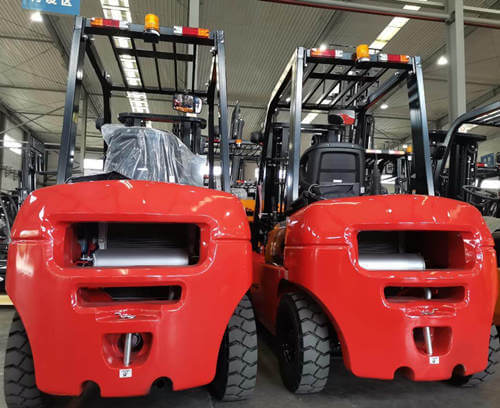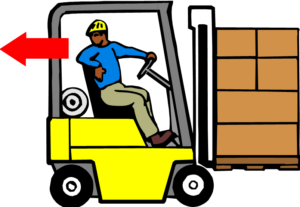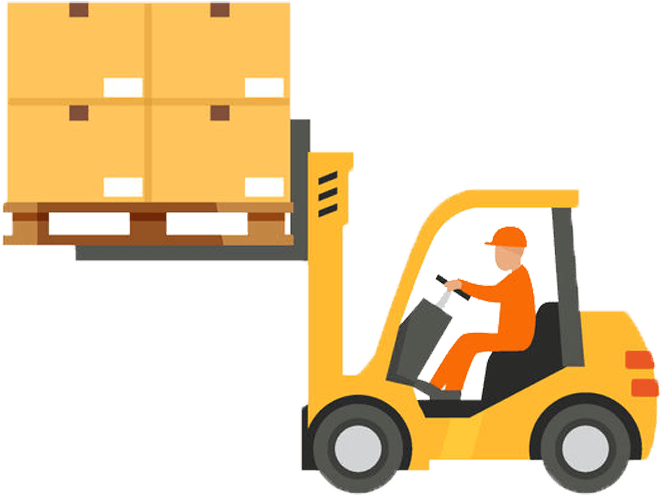
When comes to the forklift weigh, many people have no specific idea for that. But during operation, it’s very important to know this weight information.
When during transporting, or driving it on trailers, or for multi-story building, you don’t want the forklift was too heavy and drop on the Ground, resulting in thousands of dollars of damage or even worse injuring people around and workers.

The stability of a forklift, usually is decided by the load capacity, weight distribution, dimension, shape.
Forklift, is designed to carry a specific load at a specific load center, usually 500mm for Forklift under 5.0T. This means that the forklift’s load capacity is decided as if the load was a regular cube whose weight is evenly distributed.
For example, the center gravity is right in the center of the cube. Also, it’d under the assumption that the load cargo is placed on a standard pallet for example 1200mm*1200mm.
However, in reality, most cargo are not regular cubes whose gravity center is rightly in the middle.

Usually the load is different from the theory load figure. For example, if it’s irregularly shaped, it will have unbalanced weight distribution. Also if the cargo is not centered on the forks that the load capacity will be reduced as well.
How to know forklift weight?
The service weight of a forklift is a different conception. It’s not refer to the load capacity.
Service weight is the total weight including everything on the forklift, like the battery it’s equipped, or forklift attachment it’s fixed.
It’s a good way to ask for manufacture for such weight information. Usually the manufacture will weigh the forklift before delivery. So they have the exact and accurate weight information. If this I not so convenient to you, you can also visit that forklift manufacture’s website for forklift specifications.
In addition, there is an general idea about the service weight generally be 1.5-2.0 time of the load capacity of the forklift.
For example, if the forklift is 2.5T, the service weight of this forklift could be somewhere between 3.75t-5.0t. But be aware that this range is just the rough information. Please always stick to the manufacture information regarding the specific forklift.
How to figure out the safe load capacity?
Assume a 2.5T forklift whose load center is 500mm. It needs to carry a load whose load center is longer than 500mm, let’s say 700mm. We can recognize right away that the safe load capacity for this forklift will be less than 2.5T. But for the exact safe load number, you have to ask the forklift supplier a careful calculation for you.
Pls bear in mind that, factory usually have a limited overload capacity for a forklift, usually for 10-20%. FORKFOCUS forklift, is able to overload for extra 20% capacity.
For example, 2.5T FORKFOCUS forklift, able to carry 3.0T cargo if the load center is rightly 500mm. For 3.0T. It can carry 3.5T cargo without no problem if keep the load center at 500mm.
Forklift counter balance.

Forklift counter balance is located in the rear forklift. It acts as a counter balance to go against the loading cargo. It keeps the forklift from tipping forward. You can just think of the level principle.
When loading the cargo, the combined center of gravity of the forklift and the load will move forward. But the forklift will not tip over as long as the load is centered and not exceed the rated load capacity.
But if the load is too heavy and exceed the rated load capacity, or it’s placed in the end of forks, so the load center becomes bigger, this will result in some load capacity lost and will cause the forklift to tip forward.
Pay attention to forklift date plate.

Forklift is standard equipped with nameplate, from which, we got to know the essentially basic information about that forklift.
Usually it includes such information: Model name, load capacity, service weight, Load center, Serial Number, Year of Manufacture,Engine power, lifting mast height. Operator should read these information in order to understand the forklift and avoid forklift accident.

